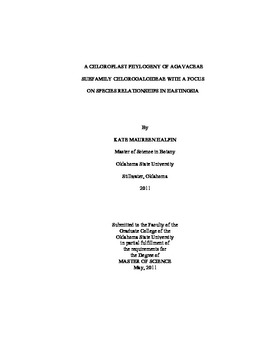| dc.description.abstract | Serpentine soils contain toxic concentrations of metals, giving rise to plant populations with specialized adaptations, but also with high levels of endemism and extreme rarity. Among the serpentine endemic and tolerant taxa of western North America are species of the closely related genera Chlorogalum, Camassia, and Hastingsia. Along with Schoenolirion, these genera comprise the subfamily Chlorogaloideae (sensu Speta of Hyacinthaceae; 1998). Phylogenetic analyses strongly support their placement in Agavaceae, however relationships within this group and their relationship within Agavaceae are largely unknown. Furthermore, a dispute on species circumscription within Hastingsia, ranging from two to four species, has prompted a more focused investigation at the population level. This study composed phylogenetic analyses based on chloroplast DNA to estimate these relationships and explore the evolution of serpentine tolerance among these genera. The monophyly of Chlorogaloideae (i.e., Chlorogalum, Camassia, Hastingsia, and Schoenolirion) was not supported as monophyletic, with Schoenolirion placed in a clade with Hesperoyucca and Hesperaloe. However, Chlorogalum, Camassia, and Hastingsia (core Chlorogaloideae) were highly supported as monophyletic, as was the sister relationship of Hastingsia and Camassia. The placement of Hesperocallis was either moderately supported as sister to the core Chlorogaloideae or unresolved in with the core Chlorogaloideae and the Schoenolirion, Hesperoyucca, and Hesperaloe clade. The genera of Chlorogaloideae were each highly supported as monophyletic, but Chlorogalum was not, with two species placed outside of the rest of the core Chlorogaloideae. No species of Hastingsia was supported as monophyletic, but was not statistically supported. However, large-scale geographic structure within the genus was found, with three major clades recovered in the phylogeny corresponding to large geographical regions. Ancestral character reconstructions of serpentine tolerance in the core Chlorogaloideae suggested multiple origins for the adaptation onto serpentine soils. | |
